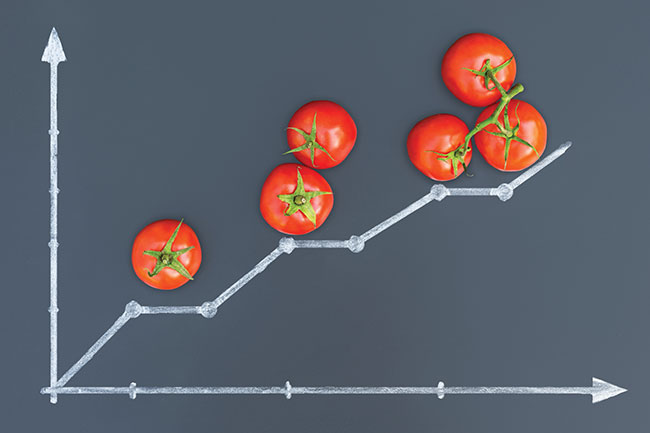
Features
Benchmarking in Ontario
Comparing your operation’s finances to those of other growers.
November 17, 2022 By Treena Hein
 OMAFRA’s financial analysis and benchmarking project posts performance results each year for 11 Ontario farm types, including greenhouse flowers, cucumbers, tomatoes and peppers.
Photo: © Peter / Adobe Stock
OMAFRA’s financial analysis and benchmarking project posts performance results each year for 11 Ontario farm types, including greenhouse flowers, cucumbers, tomatoes and peppers.
Photo: © Peter / Adobe Stock Several years ago, Ontario Ministry of Agriculture, Food & Rural Affairs ‘Business Analysis and Cost of Production Specialist’ John Molenhuis and his team began a financial analysis and benchmarking project for Ontario farms.
The performance results are posted to the OMAFRA website each year for 11 Ontario farm types, including cash crop, swine, beef, sheep, dairy goat, apple, grapes and greenhouse flowers, cucumbers, tomatoes and peppers.
“We draw data from those farmers participating in the provincial Agristability farm business risk management program,” Molenhuis explains. “Our analysis helps both those farmers and other farmers benchmark their operations. They can examine different costs and margin levels, including their operating costs and the ratio of some of those costs, for example, cost of annual labour against gross annual profit. For greenhouse operations, labour and heating are the largest cost categories. By looking at the data you can see what performance levels all the greenhouse operators in the project are achieving, and also what the top 25 per cent are achieving and see if your performance is on par.”
Molenhuis explains that these financial measures are a direct reflection of operational efficiency. “They are relating input costs as a percentage of farm revenue, and therefore, how effectively the farm is managing costs and generating outputs,” he says. “The power of comparison, of benchmarking, is seeing your areas of strength and areas of concern, where you can improve. It helps you become one of the top producers, if you aren’t already there.”
In terms of controlling costs, Molenhuis says greenhouse operators and other farmers can focus their management time first on those areas that are more cost intensive. “From there, investigate individual costs within those categories or other categories,” he says, “for opportunities to improve.”
Participation levels
The analysis was started in 2016, using 2015 data. The number of farmers participating each year in Agristability has decreased to some extent since then, and as a result, the number of farms included in the performance results has declined some over time as well. This could be due to program changes over time or other factors.
From 2015 to 2019, the number of greenhouse tomato and pepper participants stayed fairly steady (five-year average of 45 and 23 participants respectively) but declined a little for flowers and declined quite a bit for cucumbers, with a five-year average of 76 and 65 participants respectively. (And if you are wondering, to consider an operation to be “greenhouse tomato” for example, 80 per cent or more of their commodity sales must come from that crop).
“This spring (2022) we published 2019 analysis and we’re now in the process of analyzing 2020,” Molenhuis says. “We will have 2021 data in early 2023.”
Tomatoes
Overall, from 2015 to 2019 for all tomato greenhouse participants, interest expenses went up. However, direct operating expenses went down overall, reflecting natural gas price trends. Other direct operating expenses can include equipment, salaries, storage/drying, small tools, building repairs, soil and crop testing, shipping and electricity.
Overhead expenses stayed similar over the five years. These include insurance premiums outside Agristability, if any, advertising and promotion, memberships/subscriptions, office expenses, legal and accounting fees and licenses/permits.
It’s in the expense ratios (specific costs measured against overall revenue) where we see interesting differences between all participants and the top 25 per cent.
First, let’s look at all participants. As a group, all greenhouse tomato participants saw the ratio increase for interest costs (from 1.3 to 4.1), operating costs (92.8 to 94.6), labour (27.2 to 28.3) and crop inputs (14.9 to 16.7). Machinery operation dropped from 5.0 to 3.9.
As expected, the ratio for everyone for energy costs dropped from 14.5 to 13.1. However, the top 25 per cent of participants saw their expense ratio for energy costs drop from 13.1 to 10.2. That means this ratio for top performers actually started at a point in 2015, 13.1, that was the same ratio point all participants dropped to on average in 2019. In other words, their energy use efficiency was much higher from the start.
Two expense ratios, as expected, increased less for the top performers than was seen in the average for all performers. Their interest expense ratio went from 0.5 to 3.5 and operating expense ratio from 79.5 to 81.0.
The crop inputs expense ratio for top tomato growers increased in a similar way to that for all participants, from 11.4 to 15.9.
Machinery expense ratio for these top performers dropped more than for all participants, from 6.4 to 3.9 compared to 5.0 to 3.9 for all participants. Machinery expenses can include machinery repairs, licenses, insurance, lease, rental, freight and shipping. It would seem that these top performers perhaps invested in equipment (likely more efficient in terms of labour and energy) compared to the entire group.
Most interestingly, the labour expense ratio (again, labour as a cost compared to gross revenue) increased more for the top performers compared to all participants, from 22.2 to 27.1.
“This could represent a higher investment in labour,” says Molenhuis. “From the data, we don’t know what the management and/or production practices made the difference for the top farms. But it does give you insights into areas of costs where you may differ from the top farms to provide a starting point to investigate those areas for opportunities to improve.”

Ontario Ministry of Agriculture, Food & Rural Affairs ‘Business Analysis and Cost of Production Specialist’ John Molenhuis says these financial measures are a direct reflection of operational efficiency.
Photo: © Anastasiia / Adobe Stock
Results across veggie groups
For peppers, there were some differences compared to tomato. Interest expenses stayed steady as opposed to increasing a little, but direct operating expenses went down a little, similarly to tomatoes.
Overhead expenses stayed steady for peppers and cucumbers, similar to tomatoes.
In terms of all-participant cost ratios, energy dropped for peppers and cucumbers in a similar way to tomatoes as expected. However, all other expense ratios (interest, operating, labour, machine, crop inputs) for peppers went down, where for tomatoes they increased.
For top pepper performers, expense ratios went up for machinery, similar for top tomato performers. Labour and crop input ratios only went up a little for pepper producers, less than for tomatoes. However, interest and operating expense ratios went down, where for top tomato producers, they went up.
For all cucumber participants, direct operating expenses went down a little, similar to peppers and cucumbers. Interest expenses were steady, as they were for peppers.
The expense ratios for all cucumber operations went down a little for interest, operating expenses and machinery operation, similar to peppers. Labour went up, as it did for tomatoes. However, crop input expense ratio stayed steady, which is different that both other crops (tomato went up and peppers down).
Looking at the top cucumber growers, crop inputs went up a little, like both other crops, and machinery went down quite a bit, like both other crops. Labour went up, like tomatoes, as did interest expenses, but operating expenses went down, similarly to peppers.
Data as a whole
Molenhuis notes that “it’s clear that among all farm types – greenhouse, orchard, livestock etc. – is that the top producers are doing a little better job in a lot of the categories, slightly but consistently better.”
He adds, “so, once you do your own financial analysis and compare to them, if you find you are not a top performer in energy or labour or another category, you can drill down into the larger cost categories and look at what you could do differently. As mentioned, labour and heating are the big ones for greenhouses, then beyond those, look at inputs like seeds, fertilizer, pollination services and so on.”
It may seem difficult to achieve higher efficiencies, but if some greenhouse operators are having success with keeping costs lower, others can as well. Compare your farm performance at the OMAFRA Farm Finance Statistics site here: https://www.ontario.ca/page/farm-finance-statistics.
Print this page